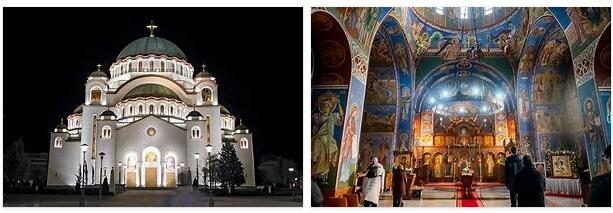Serbian Orthodox Church, the Autocephalous Orthodox Church of the Serbian Patriarchate.
The Serbian Orthodox Church is an autocephalous church. It has the rank of patriarchy with its seat in Belgrade. She gained her independence in 1219.
Structure and distribution
The head of the Serbian Orthodox Church is the “Archbishop of Peć, Metropolitan of Belgrade and Karlovci and Patriarch of the Serbs”. The seat of the Patriarch is Belgrade, liturgical languages are Church Slavonic, Serbian and, in the English-speaking diaspora, English.
The jurisdiction of the Serbian Patriarchate includes 40 dioceses and metropolitanates worldwide. The number of believers is estimated at around 8 million (almost 3 million living outside of Serbia and Montenegro). The »Serbian Orthodox Diocese for Central Europe« (seat: Hildesheim-Himmelsthür) includes around 300,000 Serbian Orthodox Christians in Germany.
The Macedonian Orthodox Church also belongs to the jurisdiction of the Serbian Patriarchate according to the general orthodox legal conception. National church efforts in Montenegro have been associated with the Montenegrin Orthodox Church since 1993.
The Serbian Orthodox Church is a member of the World Council of Churches.
History
The beginnings of isolated Christian missions among the Serbs go back to the 7th century, the roots of the Serbian church organization in the time of Prince Mutimir († 891) of Raszien, who finally accepted the Orthodox faith in 891. However, an independent Serbian Orthodox Church did not emerge until the 13th century under Sava as the first archbishop, who in 1219 obtained the autocephaly of the Serbian archbishopric from the Ecumenical Patriarch. In 1346, Stephan IV. Dušan elevated this to a patriarchate (seat in Peć; recognized by the Ecumenical Patriarchate in 1375). Under the Turkish rule, the Serbian Patriarchate Peć was abolished in 1459 and subordinated to the Archdiocese of Ohrid, rebuilt in 1557 and abolished again in 1766.
After the disintegration of old Serbia and the emigration of many Serbs to Slavonia and southern Hungary, independent Serbian jurisdictions were formed in Montenegro (Metropolie Cetinje), Dalmatia and Sirmia. In the Principality of Serbia, the metropolitans of Belgrade achieved autonomy in 1831 and autocephaly in 1877/79. In 1918 the Serbian churches merged in the newly created “Kingdom of Serbs, Croats and Slovenes” to form the Serbian Orthodox Church, which in 1920 was recognized by the Ecumenical Patriarchate as the Serbian Patriarchate. The break-up of the Yugoslav state in 1941 also led to the temporary destruction of the church structure and, within the sphere of influence of the state of Croatia, to an abundance of anti-orthodox measures (murders, forced conversions, expulsions, destruction of churches and monasteries).
Belgrade
According to andyeducation, Belgrade (Serbian Beograd), is the capital of the Republic of Serbia, located at the confluence of the Sava and Danube, with (2018) 1.7 million residents.
The city has an important Danube port and two universities. It is a congress and trade fair city and has a diverse industry.
Of the old buildings, the fortress and a mosque from the Turkish era have been preserved. The mighty Serbian Orthodox Cathedral (built from 1935) is 77m high.
Belgrade goes back to the Roman military camp Singidunum set up under Augustus. It was Hungarian from 1426–1521, then Ottoman until 1867.
Niš
Niš [ni ː ʃ ], Nisch [n ɪ ʃ, ni ː ʃ ], city in Serbia, 207 m above sea level, on the Nišava near the confluence with the Southern Morava, (2011) 183 200 residents.
University (founded 1965), library, museum. Niš is the economic center of southern Serbia, with mechanical engineering, electrotechnical-electronic, chemical, textile and food industries. The route to Sofia and Istanbul branches off in Niš from the most important north-south traffic axis of the Balkan Peninsula (Morava – Vardar – Furche).
Remains of the summer residence of Constantine I and the associated villas, thermal baths and floor mosaics were uncovered in the Mediana district. A crypt with frescoes (4th century AD) was found in a Roman necropolis. The fortress dates from the Turkish period (built 1690–1732 on the site of a Roman fort and the medieval Serbian castle) with two gates; Mosque, parts of the hammam and arsenal (now a museum); likewise the skull tower with originally 952 skulls of rebellious Serbs, which the Pasha of Niš had mortared in in 1809. In the vicinity of Niš, near Kuršumlija, there are the ruins of an early Byzantine Church of Our Lady (renovated at the end of the 12th century) and the Church of St. Nicholas (12th century).
Niš, emerged from a settlement of the Dardans, the Roman Naissus (4-6 AD Castrum, after 164 Municipium), birthplace of Constantine I the Great, was devastated by the Huns and Avars, under Justinian I the Great, rebuilt and came into Bulgarian possession in the 9th century, Hungarian in the 11th century, and Serbian possession at the end of the 12th century; 1386–1878 under Turkish rule and 1915–18 occupied by Bulgaria.
In the battle of Niš in October 1443, the Hungarian imperial administrator J. Hunyadi was victorious over a Turkish army. – On September 23, 1689, Margrave Ludwig Wilhelm I of Baden-Baden (“Türkenlouis”) also defeated the Turks near Niš.
